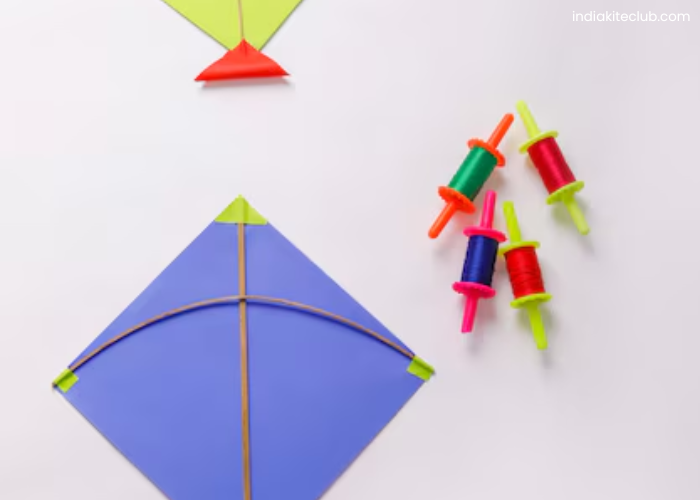Flying a kite is one of the most joyful experiences, connecting people with the wind and sky. At India Kite Club, we believe that making your own kite adds even more excitement to the experience. This guide will take you through everything you need to know about kite making, from materials to designs and expert tips.
Related:-
Best Kites for Every Wind Condition
Materials Needed for Kite Making
1. Frame Material
- Bamboo Sticks – Lightweight and flexible, making it perfect for kites.
- Plastic Straws – A good alternative for small kites.
- Wooden Dowels – Sturdy and ideal for large kites.
2. Kite Paper or Fabric
- Tissue Paper – Lightweight and good for traditional kites.
- Plastic Sheets – Durable and weather-resistant.
- Ripstop Nylon – Strong and used for professional kites.
3. Adhesives and Fasteners
- Glue Stick – Best for attaching paper materials.
- Tape (Masking or Duct Tape) – Provides extra reinforcement.
- Thread or String – Needed for binding the frame securely.
4. Kite String
- Cotton Thread – Common for small kites.
- Nylon or Polyester String – Strong and suitable for bigger kites.
- Manja (Glass-Coated String) – Used in kite battles (Handle with care!).
5. Tail and Decorations
- Ribbons – Help maintain balance and add beauty.
- Paper Strips – Lightweight and traditional.
- Fabric Pieces – Durable and stylish.
Different Kite Designs
1. Diamond Kite
- The most common and easiest to make.
- Requires a simple cross frame with a diamond-shaped covering.
- Suitable for beginners and flies well in light winds.
2. Delta Kite
- Triangular-shaped kite with excellent stability.
- Needs a lightweight frame and fabric covering.
- Works well in medium winds and is easy to control.
3. Box Kite
- A three-dimensional design providing high stability.
- Needs a strong frame and fabric covering.
- Best for high altitudes and strong winds.
4. Fighter Kite
- A lightweight, fast-moving kite used in competitions.
- Usually made with paper and bamboo.
- Requires strong string control for aerial maneuvers.
5. Sled Kite
- A frameless kite that relies on wind pressure for shape.
- Easy to construct and transport.
- Best for children and casual flying.
Step-by-Step Guide to Making a Kite
1. Choose a Kite Design
Pick a design based on wind conditions and your skill level. A diamond kite is best for beginners.
2. Prepare the Frame
- Cut the bamboo sticks or dowels to the required length.
- Arrange them in the desired shape and secure them with thread and glue.
3. Attach the Kite Cover
- Cut the kite paper or fabric slightly larger than the frame.
- Wrap and glue or tape it around the frame securely.
4. Add a Tail
- Attach a ribbon or paper strip to the bottom.
- This helps balance the kite and keep it stable in the air.
5. Tie the Kite String
- Make a small hole near the center of the kite.
- Tie the string tightly to ensure proper flight control.
6. Test and Fly
- Go to an open area with good wind conditions.
- Hold the string, run slightly, and let the wind lift the kite.
Expert Tips for Successful Kite Flying
1. Pick the Right Location
- Choose an open field away from trees and power lines.
- Beaches and parks are great locations for kite flying.
2. Understand Wind Conditions
- Light wind (5-10 mph) is ideal for small kites.
- Medium wind (10-20 mph) suits larger and more stable kites.
- Avoid flying in storms or extremely strong winds.
3. Adjust the Kite String
- Keep the string at the right length for better control.
- Adjust angles to stabilize the kite mid-flight.
4. Keep Extra Materials
- Carry spare string, tape, and paper for repairs.
- A sudden tear can be fixed quickly with a bit of tape.
5. Practice Controlling the Kite
- Move with the wind to maintain stability.
- Learn to pull and release the string to control altitude.
Common Kite Flying Problems and Solutions
1. Kite Won’t Fly
- Check if the wind is too weak or strong.
- Ensure the frame is sturdy and lightweight.
2. Kite Spins Too Much
- The tail may be too short; add more length.
- Adjust the string attachment point slightly.
3. Kite Crashes Quickly
- Make sure the frame is balanced.
- Reduce the weight of the kite paper or fabric.
4. Kite Drifts to One Side
- One side might be heavier; adjust the balance.
- Check if the frame is properly aligned.
5. String Breaks Frequently
- Use a stronger string material like nylon.
- Avoid flying in extremely strong winds.
FAQs
1. What is the best material for making a kite?
Tissue paper and plastic are great for lightweight kites, while ripstop nylon is best for professional use.
2. Can I make a kite without a tail?
Yes, but tails help maintain balance and stability, especially in strong winds.
3. How high can a kite fly?
Depending on the wind and string length, a kite can reach 300-500 feet or more.
4. Is it safe to use Manja string?
Manja string is dangerous and can cause injuries. Use it only with extreme caution or opt for regular kite strings.
5. What is the best time to fly a kite?
Morning or late afternoon when the wind is steady and not too strong.
Conclusion
Making and flying a kite is an enjoyable and rewarding experience. At IndiaKiteClub, we encourage everyone to try crafting their own kite and experiencing the thrill of flying it high. With the right materials, a little creativity, and the right weather conditions, you can create a kite that soars beautifully. So grab your materials, follow these steps, and let your kite touch the sky!

